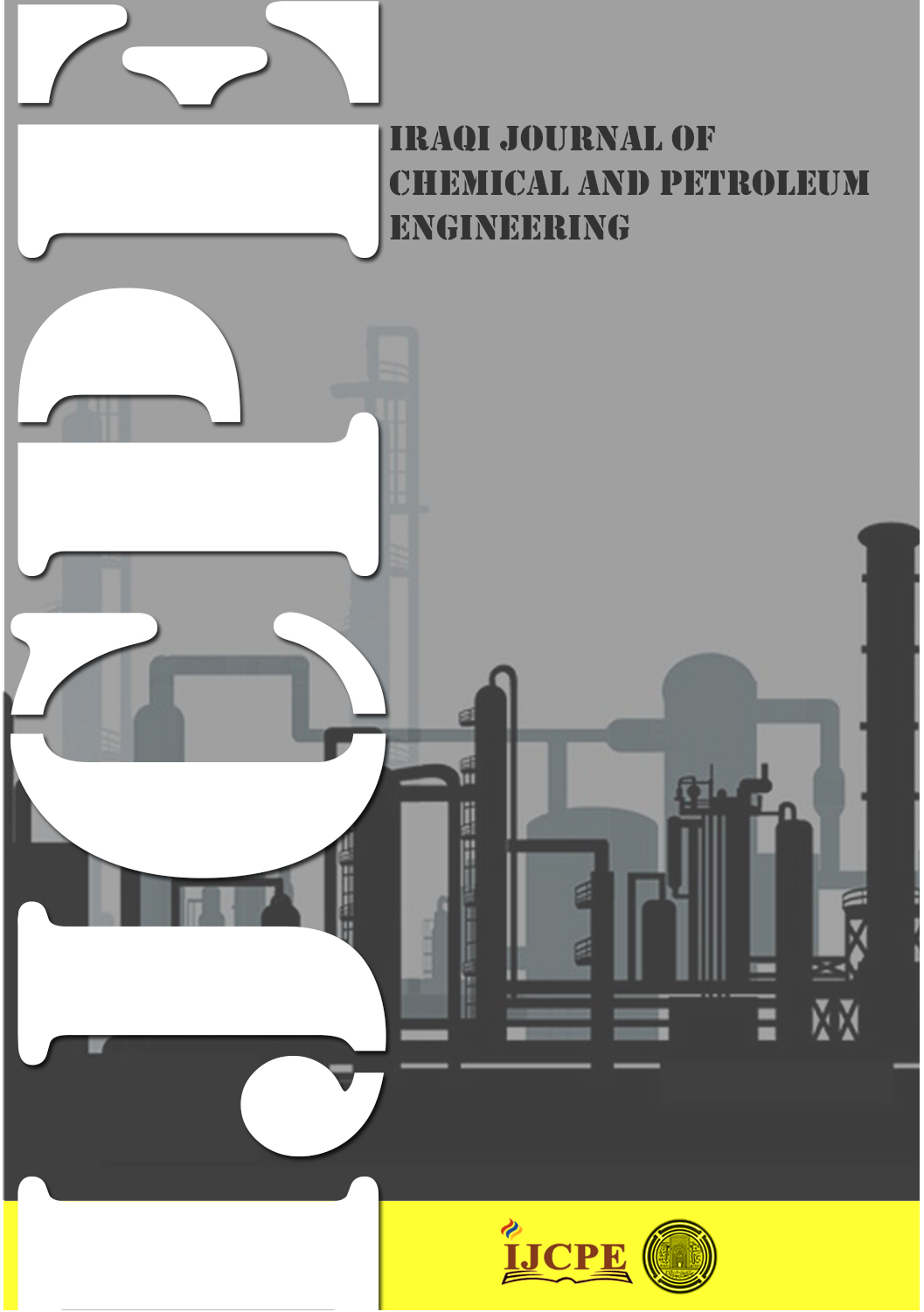Enhance the rheological properties of reservoir drilling fluid (RDF) using Fe2O3 as nanoparticle material
DOI:
https://doi.org/10.31699/IJCPE.2025.1.15Keywords:
Reservoir drill-in fluids; nanoparticles; fluid loss; filtration; Mishrif formation; thermal stabilityAbstract
An effective drilling operation relies substantially on a reliable drilling fluid system, significantly impacting its success. Drilling fluids, particularly reservoir drill-in fluids (RDF), are crucial for minimizing formation damage and maximizing output. As soon as the reservoir is drilled, formation deterioration starts; thus, an optimized RDF with minimal harm is essential considering geology, reservoir fluids, and other factors. This study aims to improve reservoir drilling fluid to minimize skin damage by comparing nanoparticle-based RDFs with conventional drilling fluids used in the Mishrif formation, drilled horizontally 3000 meters. Employing nanoparticles in drilling fluids can improve performance and thermal resistance up to 300°F. Laboratory tests and field data were compared in this study. Nanoparticles in both freshwater and saltwater drilling fluids showed significant enhancements in filtration parameters and rheological qualities. Results indicated that the RDF with Fe2O3 nanoparticles enhanced filtration properties and stability. Optimal Fe2O3 concentrations were 1g at 300°F and 1.5g at 400°F. Adding Fe2O3 nanoparticles to reservoir drilling fluid resulted in a 40% reduction in fluid loss rate and decreased mud cake thickness. Additionally, nanoparticles improved the flow properties of the drilling fluid at high temperatures up to 200°F, ensuring a controlled and more consistent decrease in parameters such as plastic viscosity (PV), yield point (YP), and gel strength without any indication of thermal deterioration.
Received on 22/05/2024
Received in Revised Form on 02/09/2024
Accepted on 02/09/2024
Published on 30/03/2025
References
[1] M. R. Annis and M. V. Smith, “Drilling fluids technology,” Exxon Company, USA, 1974. Accessed: Nov. 21, 2022.
[2] N. S. Majeed and D. M. Naji, “Synthesis and Characterization of Iron Oxide Nanoparticles by Open Vessel Ageing Process,” Iraqi Journal of Chemical and Petroleum Engineering, vol. 19, no. 2, pp. 27–31, 2018. https://doi.org/10.31699/IJCPE.2018.2.5
[3] H. Abdul Hadi and H. Abdul Ameer, “Experimental Investigation of Nano Alumina and Nano Silica on Strength and Consistency of Oil Well Cement,” Journal of Engineering, vol. 23, no. 12, pp. 51–69, 2017. https://doi.org/10.31026/j.eng.2017.12.04
[4] F. H. M. Almahdawi and K. Saad, “Enhancement of Drilling Fluid Properties Using Nanoparticles,” Iraqi Journal of Chemical and Petroleum Engineering, vol. 19, no. 2, pp. 21–26, 2018. https://doi.org/10.31699/IJCPE.2018.2.4
[5] R. Augustine and A. Hasan, Cellular response to nanobiomaterials. In Woodhead Publishing series in Biomaterials, 2020, pp. 473-504. https://doi.org/10.1016/b978-0-08-102967-1.00022-0
[6] T. Zanwer, A. A. Jagar, and A. S. Mohammed, “Sustainable aspects behind nano-biodegradable drilling fluids: A critical review,” Geoenergy Science and Engineering, no. January, 2023. https://doi.org/10.1016/j.geoen.2023.211443
[7] Krishnan, S., Abyat, Z. and Chok, C, “Characterization of Boron-Based Nanomaterial Enhanced Additive in Water-Based Drilling Fluids: A study on Lubricity, Drag, ROP and Fluid Loss Improvement ”, SPE/IADC Middle East Drilling Technology Conference and Exhibition, Society of Petrolem Engieers, 2016. https://doi.org/10.2118/178240-MS
[8] Davoodi, S., Ramazani S.A., A., Jamshidi, S. and Fellah Jahromi, A, “A novel field applicable mud formula with enhanced fluid loss properties in High Pressure-High Temperature well condition containing pistachio shell powder” Journal of Petroleum Science and Engineering, 162, 378–85. 2018. https://doi.org/10.1016/j.petrol.2017.12.059
[9] Dejtaradon, P., Hamidi, H., Michael, H.C., Wilkinson, D. and Rafati, R, () “Impact of ZnO and CuO nanoparticles on the rheological and filtration properties of water-based drilling fluid”. Colloids and Surfaces A: Physicochem Eng Aspects, Elsevier B.V, 2019. https://doi.org/10.1016/j.colsurfa.2019.03.050
[10] Nwabueze, Q.A. and Ighalo, J.O. “Utilisation of Sweet Potato (Ipomoe batatas) and Rice Husk (Oryza sativa) Starch Blend as a Secondary Viscosifier and Fluid Loss Control Agent in Water-based Drilling Mud” Petroleum and Coal, 62, 171–98. 2020.
[11] A. H. Assi, “Potato Starch for Enhancing the Properties of the Drilling Fluids,” Iraqi Journal of Chemical and Petroleum Engineering, vol. 19, no. 3, pp. 33–40, 2018, https://doi.org/10.31699/IJCPE.2018.3.4
[12] J. A. Ali et al., “Development of a Nanobiodegradable Drilling Fluid Using Prosopis farcta Plant and Pomegranate Peel Powders with Metal Oxide Nanoparticles,” ACS Omega, vol. 7, no. 35, pp. 31327–31337, Sep. 2022. https://doi.org/10.1021/acsomega.2c03492
[13] J. Yang and S. Tighe, “A Review of Advances of Nanotechnology in Asphalt Mixtures,” Procedia - Social and Behavioral Science, vol. 96, no. Cictp, pp. 1269–1276, 2013. https://doi.org/10.1016/j.sbspro.2013.08.144
[14] X. Yang, Z. Shang, H. Liu, J. Cai, and G. Jiang, “Environmental-friendly salt water mud with nano-SiO2 in horizontal drilling for shale gas,” Journal of Petroleum Science and Engineering, vol. 156, no. May, pp. 408–418, 2017. https://doi.org/10.1016/j.petrol.2017.06.022
[15] A. V. Minakov, E. I. Mikhienkova, Y. O. Voronenkova, A. L. Neverov, G. M. Zeer, and S. M. Zharkov, “Systematic experimental investigation of filtration losses of drilling fluids containing silicon oxide nanoparticles,” Journal of Natural Gas Science and Engineering, vol. 71, no. May, p. 102984, 2019. https://doi.org/10.1016/j.jngse.2019.102984 a
[16] M. Beg, P. Kumar, P. Choudhary, and S. Sharma, “Effect of high temperature ageing on TiO2 nanoparticles enhanced drilling fluids: A rheological and filtration study,” Upstream Oil and Gas Technology, vol. 5, no. August, p. 100019, 2020. https://doi.org/10.1016/j.upstre.2020.100019
[17] V. Srivastava, M. Beg, S. Sharma, and A. K. Choubey, “Application of manganese oxide nanoparticles synthesized via green route for improved performance of water-based drilling fluids,” Applied Nanoscience (Switzerland), vol. 11, no. 8, pp. 2247–2260, 2021. https://doi.org/10.1007/s13204-021-01956-8
[18] A. R. Albajalan and H. K. Haias, “Evaluation of the Performance of Conventional Water-Based Mud Characteristics by Applying Zinc Oxide and Silica Dioxide Nanoparticle Materials for a Selected Well in the Kurdistan/Iraq Oil Field,” Advances in Materials Science and Engineering, vol. 2021, 2021. https://doi.org/10.21203/rs.3.rs-443099/v1
[19] M. T. Al-Saba, A. Al Fadhli, A. Marafi, A. Hussain, F. Bander, and M. F. Al Dushaishi, “Application of nanoparticles in improving rheological properties of water based drilling fluids,” Society of Petroleum Engineers - SPE Kingdom of Saudi Arabia Annual Technical Symposium and Exhibition 2018, SATS 2018, pp. 1–10, 2018. https://doi.org/10.2118/192239-MS
[20] Z. Wang, Y. Wu, P. Luo, Y. Tian, Y. Lin, and Q. Guo, “Poly (sodium p-styrene sulfonate) modified Fe3O4 nanoparticles as effective additives in water-based drilling fluids,” Journal of Petroleum Science and Engineering, vol. 165, no. March, pp. 786–797, 2018. https://doi.org/10.1016/j.petrol.2018.03.001
Downloads
Published
Issue
Section
License
Copyright (c) 2025 The Author(s). Published by College of Engineering, University of Baghdad.

This work is licensed under a Creative Commons Attribution 4.0 International License.













